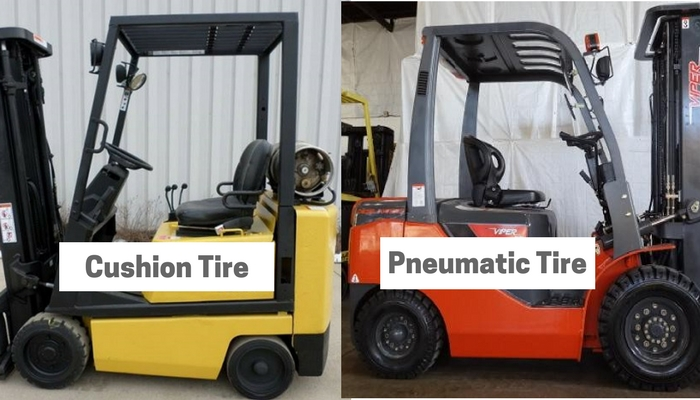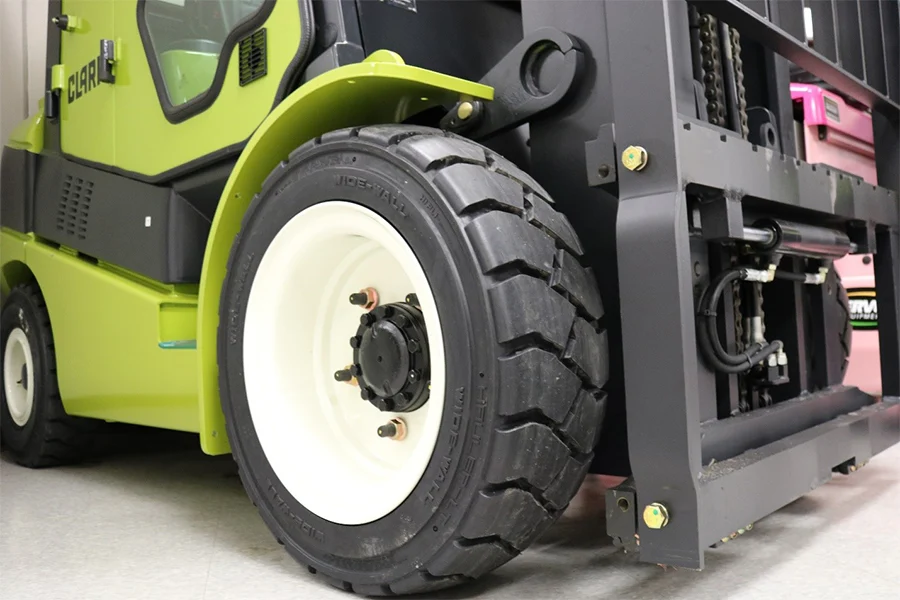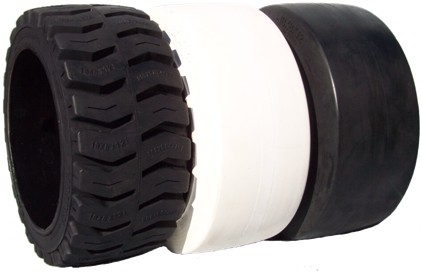Forklift Pneumatic Vs. Cushion TiresReading time: 3 minutes Table of Contents1. Summary2. Forklift Tires 3. Pneumatic Forklift Tires 4. Cushion Forklift Tires 5. Pros and Cons of Pneumatic Forklift Tires 6. Pros and Cons of Cushion Forklift Tires 7. Why Choose Lift Parts Warehouse to buy Forklift Parts? 8. Takeaways SummaryThere are two types of forklift tire options to choose from when purchasing new or replacement tires for your forklift. Pneumatic and cushion tires both have pros and cons associated with them, depending on the type of task they will be used for. This article breaks down the major differences between these two types of forklift truck tires in order to help you make the most cost-efficient tire purchase. Forklift TiresIn order to determine which type of forklift tires are best for your fleet, it is important to understand what both types look like and how they function. The main parts of any type of forklift truck tire include: The size and shape of these components will vary depending on whether you purchase pneumatic or cushion tires.
 Pneumatic Forklift TiresPneumatic forklift tires are the most common type of tire for indoor and outdoor use, and they come in a variety of sizes and load ratings to accommodate various weight capacities. These types of tires also utilize air pressure to maintain a tire's shape and the weight of the vehicle. Pneumatic tires are typically much more heavy-duty than cushion types, and they will look similar to the image below:
 Cushion Forklift TiresCushion forklift tires are typically used in indoor applications because they do not have a solid surface that could potentially damage the floor of a facility. Cushion forklift tires are also lighter duty than pneumatic tires and they do not utilize air pressure. Instead, these types of tires typically have an inner tube that is inflated to the proper operating pressure, making them more susceptible to issues related to flat tires. The image below shows a typical cushion-type tire on a forklift.
 Pros and Cons of Pneumatic Forklift TiresPneumatic tires are the more common type of tire on the market today, which means that they are also more readily available. These types of tires are typically competitively priced in comparison to cushion models, but their lower cost does come with some potential downsides. In general, pneumatic tires have a higher failure rate than cushion types, and they are more susceptible to punctures. However, this type of tire offers the benefit of being extremely durable and resistant to rollover. Pros and Cons of Cushion Forklift TiresCushion forklift tires provide many benefits over standard pneumatic styles. While pneumatic tires are typically more common in the workplace, there are many reasons to consider this option for your fleet. These types of tires have a significantly reduced risk of flat tire issues, which is great for indoor applications where dropped objects present an increased threat.
They also have a longer lifespan than pneumatic styles and they are resistant to puncture in comparison. The main downside associated with cushion models is that they are expensive when compared to pneumatic types, which may make purchasing these tires difficult if your budget is limited. Why choose Lift Parts Warehouse to buy Forklift Parts?Lift Parts Warehouse is a direct supplier of Fork Lift Parts, Lift Truck Spare Parts, Material Handling Equipments, Fork Lift Trucks, Industrial gear & shafts. We are always available for any kind of Fork Lift Spare Part inquiry & requirements at LiftPartsWarehouse.com. We stock thousands of New Genuine OEM Replacement Lift Truck Parts by all major manufacturers including:
TakeawaysBoth types of forklift truck tires have benefits and drawbacks, so it is important to consider your requirements and purchase appropriately. Forklift cushion tires are typically more expensive than pneumatic styles, but they do offer a number of benefits that may make them well worth the cost for your fleet. |

First Order Special
GET 5% OFF
On Your First Purchase!
Use this discount code
GET5%OFF

